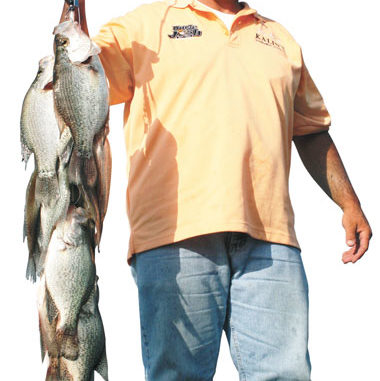
April is prime time for filling your cooler on one of South Carolina’s best crappie lakes.
If you’re looking for springtime crappie, April can often provide the best fishing of the year. This is particularly true at Lake Wateree, a mid-state hotspot known for producing lots of crappie and plenty of slabs.
The key to fishing Lake Wateree this month is understanding the transition and migration process the fish will be undergoing, moving and likely changing depths frequently as they move from prespawn to spawn patterns.
Ken Boone, a 72-year-old crappie guru, lives in the June Creek area of Lake Wateree; he’s been fishing the lake since he was two years old.
“My first fishing was off the old wooden bridges — dad would tie a rope on me in case I fell in — when I was just two years old,” Boone said. “Since that time, I learned to fish for crappie throughout the year, and while April can present challenges in terms of keeping up with the fish migrations, there’s some great fishing to enjoyed.”
Boone also owns the Colonel’s Creek Market, a grocery/tackle/bait stop adjacent to Colonel’s Creek Landing, where he specializes in dispensing the latest information on what’s going on at Wateree, fish-catching wise.
“If the weather patterns are normal and the water is in good fishing condition, I think we’ll have an outstanding spring season at Lake Wateree in 2011,” Boone said. “In the fall of 2010 — and even during the winter — a lot of really big crappie were caught. I’m excited about the prospects of a great spring season this year.
“There are several basic patterns I fish during this time of the year,” Boone said. “First of all, I approach each day with an open mind as to where the fish may be. Since I do fish quite often, I will generally begin the fish-hunting process at the same-type places I caught fish on the previous trip. During April, we still get some cold fronts that blow through, but also extended periods of warm weather, so my first adjustment will be weather-dependent if a spot that produced fish the previous trip doesn’t have crappie. If a front has blown though, I move deep first. If it has been much warmer, I’ll try shallower water.
“Water temperature is a key to their migrations toward the shallows,” he said. “Naturally, it varies from year to year as far as specific time, but when the water temperature gets to about 55 degrees, the crappie start moving into the creeks. I like to work the edge of creek channels where cover is found in 12 to 14 feet of water when this first occurs.
“When the water temperature hits the mid-60s, a lot of the crappie will begin to head to the shallows and many will gang up in eight to 10 feet of water around cover such as docks, logs and brush. Some early spawning fish will move on up to five feet or less of water.”
Boone said a key is to always have a target in mind when crappie fishing on Wateree. Crappie will orient to some form of structure, even though they will sometimes be suspended off or just above it.
“There are many depths and specific type places you can find crappies on Wateree during April,” Boone said. “First, even if we’re getting into a big spawn around the full moon in April, not all of the fish will move into real shallow water. They don’t all spawn at the same time, plus a lot of fishermen don’t realize it, but a lot of crappie will spawn in eight feet of water or deeper. Often, when I catch a lot of fish in the shallow water, they will be primarily males, so a good place to find the slabs will be near the same place, but just a bit deeper. When the females come in to spawn, they may not always come all the way in to real-shallow water, but the males will move out to where they spawn to fertilize the eggs.”
“I’ll find fish early in the month on natural stump rows along creek ledges or on humps,” he said. “In addition, toward the shallows there will be stumps, logs downed trees and docks that hold fish. Over the years, docks have become a prime target for me during springtime. I use a fast-tip, 5½-foot rod and sling-shot the jig back under and around docks. This can be an awesome place for crappie, especially during April when a lot of fish move toward the shallows. It takes a bit of practice to get the technique right, but when you get to where you can cast, sling or poke a jig back into the shady cover around dock pilings, you’re likely to catch some hefty crappie.”
Boone added that shade around docks is a key.
“Sometimes, I’ll hit a pattern that produces a lot of fish that most fishermen miss,” Boone said. “In the afternoons, as the sun gets low in the sky, there will be a shade edgeline around docks, sometimes two or three feet away from the dock. At times, I will find crappie stacked up right on that shade edgeline. I have caught several fish from a single location like this many times by just swimming my jig back right at the shade line.”
For all of this fishing, Boone sticks with a single rod and reel, unlike a lot of anglers who use multiple rigs.
“That’s just the pattern that works for me,” he said. “I fish a lot of different places, and I am fishing a specific target, not a column of water,” he said. “I know that the other methods produce plenty of crappie, but I enjoy fishing my jig on a more personal level.”
A lot of fishermen enjoy excellent results by fishing multiple rods and working a column of water; that can be extremely productive on Wateree in April.
According to Jay Bruce, a professional crappie fisherman from Greer, Wateree is one of his favorite lakes in April, and he has two basic techniques that work well there.
“I do like to fish a column of water, and early in the month, often the best technique is to use live bait in a spider-rig fashion,” Bruce said. “My tournament partner is Carolyn Reeves from Landrum, and we will use four rods each off the front of the boat. We will alternate the depth of each rod, which allows us to cover a variety of water depths. We also have the rods situated in a fanned-out manner in front of the boat so we actually cover a wide swath of water as we move along.
“During April, you can find fish throughout the lake in the creeks,” Bruce said. “We’ll work creek ledges and edgelines, humps with brush or natural cover such as stumps and points and pockets,” he said. “I do use side-scar sonar technology to help me find areas holding fish, and that can be a big help at times, so I’ll fish an area thoroughly, but also quickly. If I get some action, I’ll stick with it. If not, I’ll change locations and usually change depth patterns as well.”
Bruce said that as the water warms, long-lining jigs becomes very effective.
“As the fish begin to stage in the shallower water, we’ll troll multiple lines behind the boat,” he said. “We use Kalin jigs and will typically use small-sized jigheads in the 1/32nd-ounce size, and we use 4-pound test line exclusively. Generally, we’ll slow-troll with different lengths of line out on different rods, which will help cover different depths. Once we begin to get bites on a particular depth pattern, or grub color pattern, we’ll focus more rods in the productive zone.”
Bruce and Reeves will fish docks the way Boone does, but they also fish the pilings of the many bridges that cross major creek arms. Reeves said the bridges at Wateree, Dutchman, Taylor, Colonels and Beaver creeks are all potential crappie producers in April.
“The key here is that there is a vertical wall for the fish to relate to,” Reeves said. “They can hold at almost any depth and have that solid structure to orient to, as well as be in the shade under the bridge. Fishing bridge pilings is a very consistent pattern, but sometime you’ll have to check several places before finding the fish. We cast and swim the jig back, and we also drop it down to a specific depth and just twitch it vertically, especially if we’ve predetermined a productive depth.”

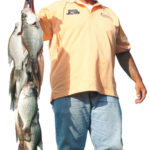
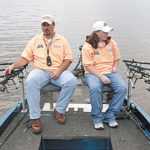
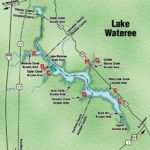
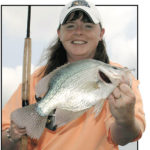
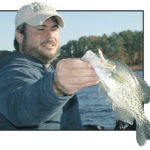



Be the first to comment